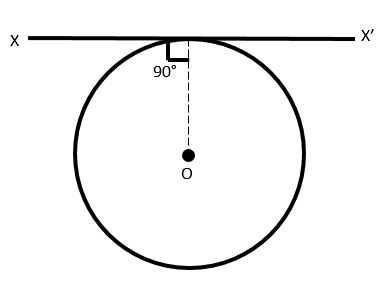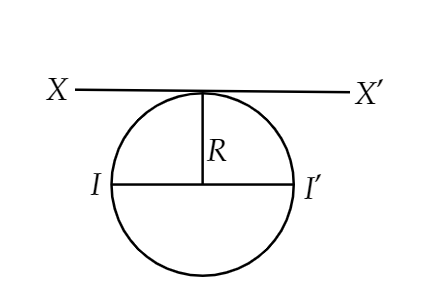
A wire of length L and uniform mass density \[\rho \] is bent into a circular loop with center at O as shown. The moment of inertia of the loop about the axis XX’ is:

A. \[\dfrac{{\rho {L^3}}}{{8{\pi ^2}}} \\ \]
B. \[\dfrac{{\rho {L^3}}}{{16{\pi ^2}}} \\ \]
C. \[\dfrac{{5\rho {L^3}}}{{16{\pi ^2}}} \\ \]
D. \[\dfrac{{3\rho {L^3}}}{{8{\pi ^2}}}\]
Answer
219.6k+ views
Hint:To find the moment of inertia of a body about an axis parallel to another axis of rotation when the moment of inertia about the known axis of rotation is known, we use the parallel axis theorem.
Formula used:
\[I = {I_{cm}} + m{d^2}\]
Here, I is the moment inertia about the required axis of rotation, \[{I_{cm}}\] is the moment of inertia of about center of mass, m is the mass of the body and d is the distance of the required axis of rotation from the center of mass.
The moment of inertia of circular loop of mass m and radius r about diameter is given as,
\[{I_O} = \dfrac{{m{r^2}}}{2}\],
Here m is the mass of the loop and r is the radius of the loop.
Complete step by step solution:
The given axis of rotation XX’ is parallel to the diameter of the loop.

Image: Wire of length L in circular form
The distance of the axis of rotation from the center of mass is \[d = r\]
The moment of inertia of the circular loop about the diameter is \[{I_{cm}} = \dfrac{{m{r^2}}}{2}\]
The mass of the circular loop of length L having linear mass density \[\rho \]is,
\[m = \rho L\]
If the radius of the circular loop is r then the circumference of the loop will be equal to the total length of loop, i.e. L.
\[2\pi r = L \Rightarrow r = \dfrac{L}{{2\pi }}\]
Putting in the expression for the moment of inertia about the axis of rotation XX’, we get
\[{I_{XX'}} = {I_{cm}} + m{d^2}\]
\[\Rightarrow {I_{XX'}} = \dfrac{{\rho L{{\left( {\dfrac{L}{{2\pi }}} \right)}^2}}}{2} + \rho L{\left( {\dfrac{L}{{2\pi }}} \right)^2}\]
\[{I_{XX'}} = \dfrac{{\rho {L^3}}}{{8{\pi ^2}}} + \dfrac{{\rho {L^3}}}{{4{\pi ^2}}}\]
\[\therefore {I_{XX'}} = \dfrac{{\rho {L^3} + 2\rho {L^3}}}{{8{\pi ^2}}} = \dfrac{{3\rho {L^3}}}{{8{\pi ^2}}}\]
Hence, the moment of inertia of the given circular loop about the axis of rotation XX’ is \[\dfrac{{3\rho {L^3}}}{{8{\pi ^2}}}\].
Therefore, the correct option is D.
Note: The moment of inertia of the circular loop about the diameter is calculated using perpendicular axis theorem. The perpendicular axis theorem is applied where the mass distribution is uniform along the plane of the body.
Formula used:
\[I = {I_{cm}} + m{d^2}\]
Here, I is the moment inertia about the required axis of rotation, \[{I_{cm}}\] is the moment of inertia of about center of mass, m is the mass of the body and d is the distance of the required axis of rotation from the center of mass.
The moment of inertia of circular loop of mass m and radius r about diameter is given as,
\[{I_O} = \dfrac{{m{r^2}}}{2}\],
Here m is the mass of the loop and r is the radius of the loop.
Complete step by step solution:
The given axis of rotation XX’ is parallel to the diameter of the loop.

Image: Wire of length L in circular form
The distance of the axis of rotation from the center of mass is \[d = r\]
The moment of inertia of the circular loop about the diameter is \[{I_{cm}} = \dfrac{{m{r^2}}}{2}\]
The mass of the circular loop of length L having linear mass density \[\rho \]is,
\[m = \rho L\]
If the radius of the circular loop is r then the circumference of the loop will be equal to the total length of loop, i.e. L.
\[2\pi r = L \Rightarrow r = \dfrac{L}{{2\pi }}\]
Putting in the expression for the moment of inertia about the axis of rotation XX’, we get
\[{I_{XX'}} = {I_{cm}} + m{d^2}\]
\[\Rightarrow {I_{XX'}} = \dfrac{{\rho L{{\left( {\dfrac{L}{{2\pi }}} \right)}^2}}}{2} + \rho L{\left( {\dfrac{L}{{2\pi }}} \right)^2}\]
\[{I_{XX'}} = \dfrac{{\rho {L^3}}}{{8{\pi ^2}}} + \dfrac{{\rho {L^3}}}{{4{\pi ^2}}}\]
\[\therefore {I_{XX'}} = \dfrac{{\rho {L^3} + 2\rho {L^3}}}{{8{\pi ^2}}} = \dfrac{{3\rho {L^3}}}{{8{\pi ^2}}}\]
Hence, the moment of inertia of the given circular loop about the axis of rotation XX’ is \[\dfrac{{3\rho {L^3}}}{{8{\pi ^2}}}\].
Therefore, the correct option is D.
Note: The moment of inertia of the circular loop about the diameter is calculated using perpendicular axis theorem. The perpendicular axis theorem is applied where the mass distribution is uniform along the plane of the body.
Recently Updated Pages
Chemical Equation - Important Concepts and Tips for JEE

JEE Main 2022 (July 29th Shift 1) Chemistry Question Paper with Answer Key

Conduction Explained: Definition, Examples & Science for Students

Analytical Method of Vector Addition Explained Simply

Atomic Size - Important Concepts and Tips for JEE

JEE Main 2022 (June 29th Shift 1) Maths Question Paper with Answer Key

Trending doubts
JEE Main 2026: Application Form Open, Exam Dates, Syllabus, Eligibility & Question Papers

Understanding Uniform Acceleration in Physics

Derivation of Equation of Trajectory Explained for Students

Hybridisation in Chemistry – Concept, Types & Applications

Understanding the Angle of Deviation in a Prism

Understanding Collisions: Types and Examples for Students

Other Pages
JEE Advanced Marks vs Ranks 2025: Understanding Category-wise Qualifying Marks and Previous Year Cut-offs

Units And Measurements Class 11 Physics Chapter 1 CBSE Notes - 2025-26

NCERT Solutions For Class 11 Physics Chapter 8 Mechanical Properties Of Solids

Motion in a Straight Line Class 11 Physics Chapter 2 CBSE Notes - 2025-26

NCERT Solutions for Class 11 Physics Chapter 7 Gravitation 2025-26

Mechanical Properties of Fluids Class 11 Physics Chapter 9 CBSE Notes - 2025-26




